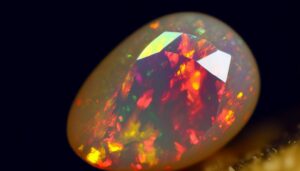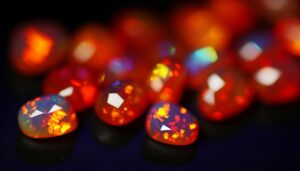Identifying Authentic Sunset Fire Opals: Facts and Tips
Sunset fire opals, forming in volcanic regions, owe their vibrant hues to light diffraction through microscopic silica spheres. The process, taking millions of years, relies on precise geothermal and chemical conditions.
These opals exhibit colors from fiery reds to cool blues, changing intensity with light angles. Their relative softness (Mohs 5.5-6.5) and hydrophane nature allow water absorption, temporarily altering appearance.
Historically valued for their passionate symbolism, they're found mainly in Mexico and are extracted with meticulous care. Proper maintenance, including avoiding extreme temperatures, preserves their integrity.
To understand their geological formation and market value deeper, continue exploring.
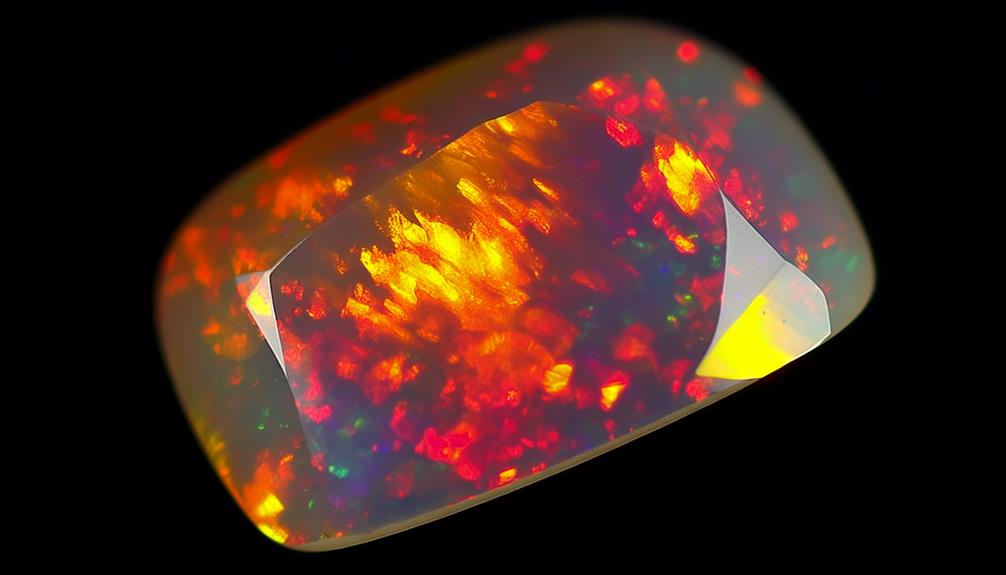
Key Takeaways
- Sunset fire opals form in volcanic regions through sedimentation over millions of years.
- Their vibrant colors range from fiery reds to cool blues due to light diffraction through silica spheres.
- These opals are hydrophane, absorbing water and temporarily altering their appearance.
- Sunset fire opals symbolize passion, creativity, and emotional intensity, historically prized by Ancient Aztecs and Mayans.
- Primarily mined in Mexico, high-quality specimens are valued for their rarity, color intensity, and clarity.
Origins of Sunset Fire Opals

Sunset Fire Opals, renowned for their vibrant play-of-color, originate primarily from volcanic regions where silica-rich waters interact with geological formations.
You'll find that these opals form when silica deposits from hydrothermal fluids fill cavities and fractures in volcanic rocks. The process, known as opalization, occurs over millions of years.
Silica gel accumulates in these spaces, gradually solidifying into opal through dehydration and polymerization. It's essential to understand that the unique geological conditions—specific temperature, pressure, and mineral content—are vital for the formation of these opals.
The interplay of these factors leads to the creation of their striking appearance. Recognizing these origins helps you appreciate the complexity and rarity of Sunset Fire Opals in the gemstone world.
Unique Color Variations
You'll find that the unique color variations of Fire Opals arise from the diffraction of light through their microscopic silica spheres, which create an impressive spectrum of hues. The size and arrangement of these spheres determine the specific wavelengths of light that are diffracted, resulting in vibrant colors ranging from fiery reds and oranges to cool blues and greens.
This optical phenomenon, known as play-of-color, is a hallmark of Fire Opals. When you observe these gemstones, you'll notice that the intensity and pattern of the colors can change with the angle of light incidence and the stone's orientation.
This dynamic interplay of light and structure makes each Fire Opal uniquely mesmerizing, showcasing nature's intricate craftsmanship.
Geological Formation
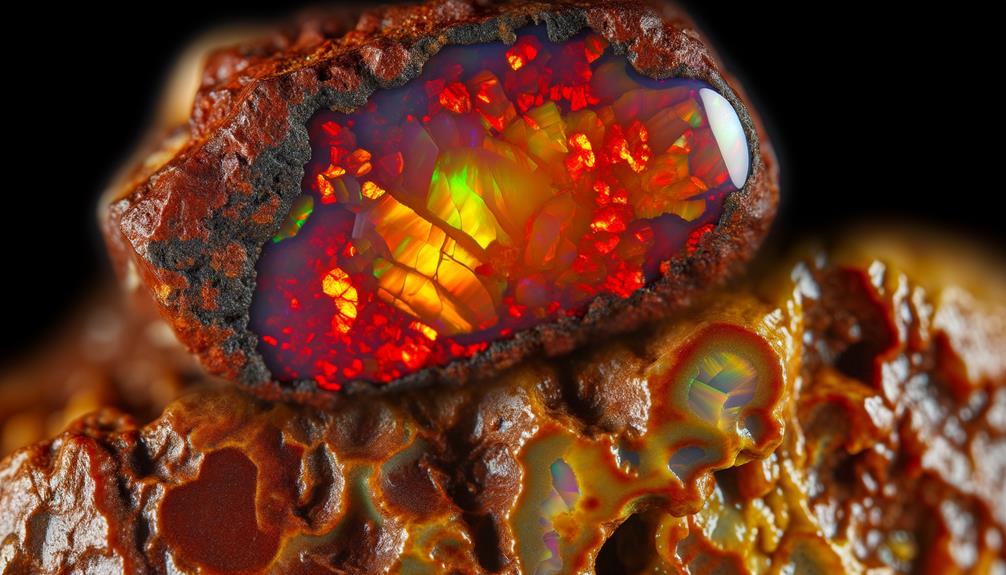
Fire Opals form in volcanic regions where silica-rich water seeps into the cracks and cavities of lava, gradually solidifying into opaline silica through a process called sedimentation.
Over time, geothermal activity influences the deposition rate, creating layers of silica spheres. These spheres, arranged in a grid-like structure, diffract light and produce the opal's characteristic play-of-color.
You'll find that the specific conditions required for Fire Opal formation include a precise balance of temperature and pH levels. High temperatures accelerate the silica deposition while maintaining structural integrity.
Variations in trace elements like iron and magnesium further influence the opal's hue, ranging from vivid reds to warm oranges. Understanding these geological processes reveals the complexity behind each Fire Opal's unique beauty.
Historical Significance
Throughout history, Fire Opals have captivated civilizations with their vibrant colors and mystical properties, often being associated with passion, creativity, and protection. Ancient Aztecs and Mayans prized these gemstones, incorporating them into elaborate rituals and intricate jewelry. You might find it fascinating that they believed Fire Opals could harness the power of the sun, imbuing the wearer with strength and cruciality.
In medieval Europe, Fire Opals were considered potent amulets, thought to ward off evil and enhance mental faculties. The gemstone's unique play-of-color, caused by the diffraction of light, has consistently made it a symbol of dynamic energy and transformation.
As you explore Fire Opals' historical significance, you'll see how their allure transcends time and culture.
Mining Locations

Primarily found in Mexico, Sunset Fire Opals are extracted from regions known for their unique geological formations, which create the perfect conditions for these vibrant gemstones.
You'll find that the majority of these opals come from the state of Querétaro, where volcanic activity has led to the formation of silica-rich deposits. These geological conditions, combined with the arid climate, contribute to the gem's remarkable color play.
Additionally, smaller quantities are mined in regions like Jalisco and Chihuahua. Each locale offers slightly different opal characteristics due to variations in geological composition.
The mining process involves meticulous extraction techniques to preserve the integrity of the opals, often requiring advanced methods such as hydraulic mining and controlled blasting to access the delicate veins.
Physical Properties
Sunset Fire Opals exhibit a unique interplay of colors due to their internal structure, which diffracts light into a spectrum of vivid hues. You'll notice their body color ranges from bright yellow to deep orange, occasionally showing hints of red. These opals possess a hardness of 5.5 to 6.5 on the Mohs scale, making them relatively soft and susceptible to scratches.
Their specific gravity varies between 1.98 and 2.20. They exhibit conchoidal fracture, meaning they break with smooth, curved surfaces. With a vitreous to resinous luster, they can appear glassy or slightly waxy. Their refractive index ranges from 1.37 to 1.47, contributing to their brilliant play-of-color.
These physical properties make Sunset Fire Opals fascinating yet delicate gemstones.
Chemical Composition
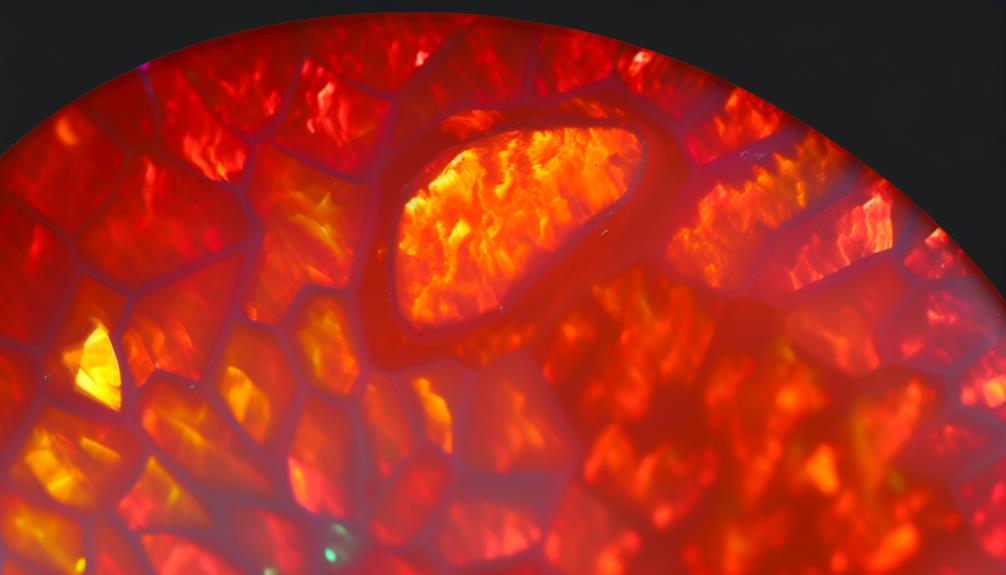
You'll find that sunset fire opals are primarily composed of hydrated silica, with the chemical formula SiO2·nH2O.
Their unique chemical properties arise from the presence of water molecules trapped within the silica structure, which can vary between 3% to 21% by weight.
This composition contributes to their distinctive play-of-color, making them a fascinating subject for detailed scientific analysis.
Composition and Structure
Often characterized by its striking play of colors, the chemical composition of fire opal mainly includes hydrated silica with trace amounts of iron oxide.
You'll find that the silica structure, SiO₂·nH₂O, is amorphous, meaning it lacks a crystalline lattice. This amorphous nature contributes to its unique optical properties.
The water content, typically ranging from 3% to 21%, plays a pivotal role in the opal's translucence and color intensity. Iron oxide (Fe₂O₃), present in minor quantities, imparts the distinctive fiery hues ranging from yellow to deep orange.
Unique Chemical Properties
The distinctive chemical properties of fire opals, such as their high water content and presence of iron oxide, contribute to their remarkable play of colors and optical phenomena.
Fire opals typically contain up to 10% water, which can affect their stability and durability.
The iron oxide inclusions give the stone its vivid, fiery hues ranging from yellow to red.
Silica spheres within the opal are responsible for diffraction, creating the gemstone's characteristic play-of-color.
This interaction of light with the microscopic silica structure results in a mesmerizing display of spectral colors.
Understanding these properties allows you to appreciate the intricate balance of composition and structure that makes fire opals so unique and visually enchanting.
Cutting and Polishing
Mastering the art of cutting and polishing sunset fire opals necessitates a deep understanding of their unique physical properties and inherent fragility.
You must first appreciate the opal's Mohs hardness of 5.5 to 6, indicating susceptibility to scratches. Employ a diamond saw for precision cutting, maintaining a slow feed rate to prevent fractures.
Use a fine-grit diamond wheel for initial shaping, followed by progressively finer abrasives. When polishing, cerium oxide or tin oxide on a felt wheel offers best results.
Monitor heat buildup, as excessive temperatures can cause crazing. Always immerse the opal in water during grinding to minimize thermal shock.
Uses in Jewelry
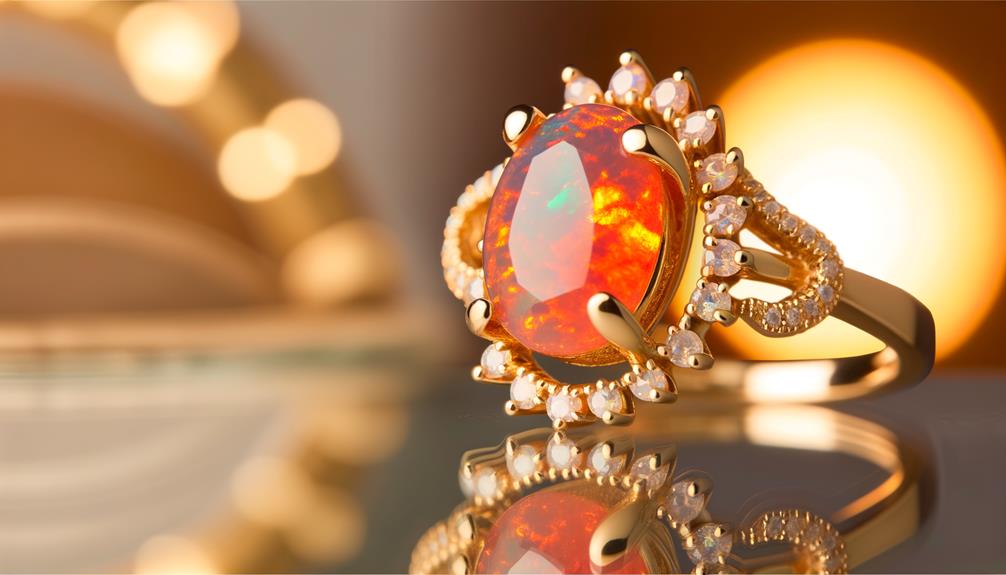
Incorporating sunset fire opals into jewelry requires a keen understanding of their optical properties and structural limitations. These opals exhibit a unique play-of-color, a phenomenon where light diffracts within the microstructure, creating vibrant flashes.
However, their relative softness (5.5-6.5 Mohs scale) necessitates careful handling. You should avoid placing these opals in high-wear items like rings without protective settings. Instead, consider pendants or earrings where physical impact is minimized.
Additionally, sunset fire opals are hydrophane, meaning they can absorb water, altering their appearance temporarily. You must inform wearers to avoid prolonged exposure to liquids.
Symbolism and Meaning
Throughout history, sunset fire opals have symbolized passion, creativity, and emotional intensity, enchanting gem enthusiasts and collectors alike. These opals are believed to stimulate the sacral chakra, thereby enhancing creative energy and emotional expression.
The vibrant hues of red, orange, and yellow mirror the fiery elements, often associated with transformation and renewal. Scientifically, the play-of-color phenomenon results from the diffraction of light through silica spheres, creating the opal's distinct appearance.
This optical property not only mesmerizes viewers but also reinforces the gem's symbolic meaning of inner fire and dynamic change. By wearing or meditating with a sunset fire opal, you can potentially harness these attributes, fostering a deeper connection to your inner passions and creative endeavors.
Care and Maintenance

To maintain the brilliance and integrity of your sunset fire opal, you must follow specific care guidelines that prevent damage and preserve its unique properties.
First, avoid exposing the opal to extreme temperature fluctuations, as this can cause cracking. Store your opal jewelry in a padded container to prevent abrasion.
Clean the opal using a soft cloth and mild detergent; avoid ultrasonic cleaners, as they may induce fractures. Additionally, minimize contact with harsh chemicals, including household cleaners and beauty products, to safeguard against surface degradation.
Regularly inspect the opal for signs of wear or damage, and consult a professional gemologist for any necessary repairs. By adhering to these instructions, you'll safeguard your opal's mesmerizing beauty and structural integrity.
Famous Specimens
While ensuring the longevity of your sunset fire opal is essential, it's equally fascinating to explore some of the most renowned specimens that have captivated gem enthusiasts worldwide.
The 'Burning Flame' opal, celebrated for its intense red and orange hues, exemplifies the vibrant play-of-color typical of high-quality sunset fire opals.
Another notable specimen is the 'Eternal Sunset,' which showcases an extraordinary balance of fire and clarity, making it a prized piece in gemological studies.
The 'Phoenix's Heart' is distinguished by its exceptional depth of color and translucency, a rare combination that enhances its allure.
These specimens not only demonstrate the geological marvels of sunset fire opals but also provide benchmarks for evaluating other gems based on color, clarity, and vibrancy.
Market Value and Pricing

When analyzing the market value and pricing of Sunset Fire Opals, you'll need to take into account current market trends and the factors influencing prices.
Market demand, rarity, and quality play critical roles in determining their value.
Current Market Trends
In today's gemstone market, sunset fire opals command significant value due to their rarity, vibrant coloration, and unique play of color. Prices have steadily increased, reflecting both collector interest and limited supply.
You'll find that high-quality specimens exhibit a mesmerizing range of warm hues, from deep reds and oranges to subtle yellows. The market has seen a growing demand, particularly from regions with a strong appreciation for fine opals, such as the United States and Japan.
Auctions and specialty gemstone retailers frequently feature these opals, often fetching premium prices. If you're considering an investment, be aware that the market favors stones with exceptional clarity and minimal inclusions.
Their alluring aesthetics make sunset fire opals a sought-after commodity in luxury jewelry.
Factors Influencing Prices
Several critical factors influence the market value and pricing of sunset fire opals. This includes color intensity, clarity, carat weight, and the presence of inclusions. You should prioritize color intensity, as vibrant reds and oranges fetch higher prices. Clarity is pivotal, with transparent specimens without cloudiness or blemishes being more valuable. Carat weight directly impacts pricing; larger opals command higher per-carat costs due to their rarity. Inclusions, while adding character, typically reduce value unless they enhance the opal's visual appeal uniquely. Consider the cut, as precision cutting maximizes light reflection, enhancing visual brilliance. Always assess these attributes scientifically to guarantee you're investing in a high-quality gemstone that justifies its market price.
Conclusion
To conclude, sunset fire opals, with their dazzling range of colors and bold hues, fascinate collectors and experts alike.
These geological treasures are created through distinct methods and carry historical weight and symbolic importance.
Discovered in particular mining sites, their economic worth fluctuates based on their brightness and scarcity.
Adequate maintenance guarantees their durability, safeguarding their radiant sheen.
By grasping these elements, you'll truly admire the fiery spectacle that's the sunset fire opal, marveling at its captivating brilliance.

